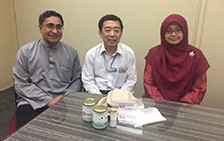Stories from the Field 2
“Green Economy” Gives Birth to New Industry!
– Promoting the Green Economy with the Palm Oil Industry in Malaysia (Good Example of SATREPS)
Palm oil is a vegetable oil obtained from the fruit of the oil palm, and is used widely in products including food and detergents. In Malaysia, the palm oil industry is supporting the economy of the countryside, including states such as Sabah, even now when the country has been industrialized. On the other hand, there are concerns over environmental pollution from the wastewater discharged from palm oil mills. For example, a large volume of methane gas, which has a greenhouse effect 25 times bigger than that of carbon dioxide, is produced from reservoirs used for treating wastewater, which are three times the area of the oil mill. Furthermore, each year, 40,000 tons of residues (bunches of fruit remaining after milling) which can be used as biomass* are discarded in one plant. Thus, it has become an important challenge to change the palm oil industry in Malaysia to a green economy (environment-friendly economy) industry.
Under such situation, Professor Yoshihito Shirai of Kyushu Institute of Technology has researched the effective use of palm oil wastewater in Malaysia for over 20 years, since 1994. In November 2013, working together with Professor Mohamad Ali of Universiti Putra Malaysia (UPM), he launched the “Project on Promotion of Green Economy with Palm Oil Industry for Biodiversity Conservation” using the “Science and Technology Research Partnership for Sustainable Development (SATREPS).” Professor Shirai says the following regarding the objective of the project.
“What is important is not just simply to process the waste so that it has no adverse impact on the environment, but to demonstrate a business model where a new industry can be produced by making use of the waste.”
Professor Shirai and other researchers conducted research and experimented repeatedly using a test equipment (pilot plant) adjacent to a palm oil plant in Sabah State, and succeeded in completely processing the palm oil wastewater without using large reservoirs. They also proved that the methane gas has potential for generating an amount of electricity more than the power required by the oil mill. Such biomass power generation has also been researched in Japan for some time, but there were few sites in the country capable of obtaining the large amount of biomass required to generate electricity, which led to high costs associated with generation, and thus, cases of its practical use had been limited. In Malaysia however, in addition to the fact that an adequate amount of wastewater for power generation is discharged even from one plant, the associated costs are lower than in Japan. As a result, the potential to stably produce 1 megawatt of electric power, year round, was demonstrated. This is enough to cover the amount of electricity used by a general plant.

Associate Professor Hidaya of UPM (on the right) who is president of a venture company that sells nanocellulose fiber, project principal researcher Professor Shirai (in the middle) and joint researcher Professor Ali of UPM (Photo: Professor Yoshihito Shirai, Kyushu Institute of Technology)

Wastewater treatment equipment, for treating palm oil wastewater and producing methane gas to be used as fuel (Photo: Professor Yoshihito hirai, Kyushu Institute of Technology)
Furthermore, a broad range of research was conducted through the SATREPS project, not only on energy and the environment, but on the fundamentals, application, and commercialization required to produce high-value-added products from biomass. UPM and Professor Shirai developed “nanocellulose fiber,” a plastic-reinforced fiber, which could potentially be applied as a material in car bodies and more, from biomass residues. They are now commercializing this fiber as a university venture. This is one of the results of the sharing of research knowhow, through joint research conducted by numerous Malaysian researchers, such as Professor Ali of UPM, with Professor Shirai.
Based on these achievements, Professor Shirai has come up with further ideas.
“What we are now proposing is to create a new industry by utilizing electric power generated from biomass resources. We are also thinking of a plan to create a vegetable plant that will require a large amount of cheap electric power, on the former site of a reservoir. Originally in Malaysia, great roads where large vehicles can drive have been developed all over the country, for the trucks transporting palm oil. These roads will be useful not only for transporting building materials for the vegetable plant, but also for the distribution of products. In other words, the conditions required for making the plant and facilities for a new business utilizing biomass resources are already established, meaning that there is a ground for producing new industries that consider the environment.”
Promoting the development of new businesses, and efforts to produce energy from waste, rather than just processing it, “will prove to be useful for environmental improvement, and surely coincides with the objective of the SDGs, in that they also create employment for the local people,” says Professor Shirai. In this sense, this project could be considered as an attempt to bring about a new perspective on the relationship between industry and environmental conservation. It is also a good example of academic research results utilizing Japanese ODA, being accepted and applied in foreign countries.
* Recyclable organic resource produced from plants and animals, such as livestock waste, raw garbage and wood chips.
<< Previous Page Next Page >>
Main Text | Reference Statistics | Stories from the Field | Master Techniques from Japan to the World | ODA Topics
